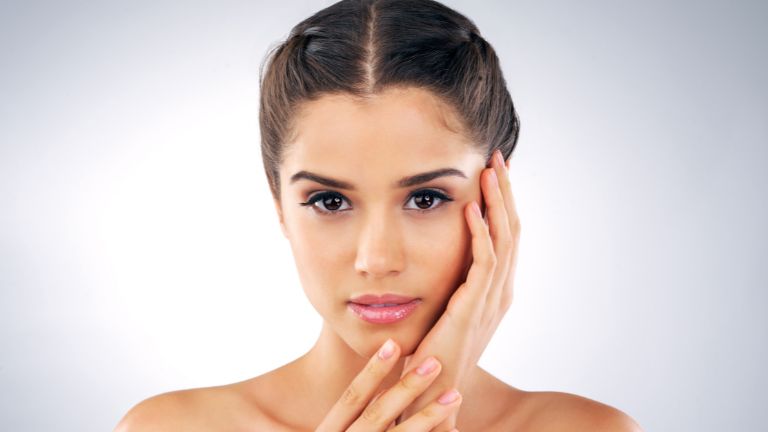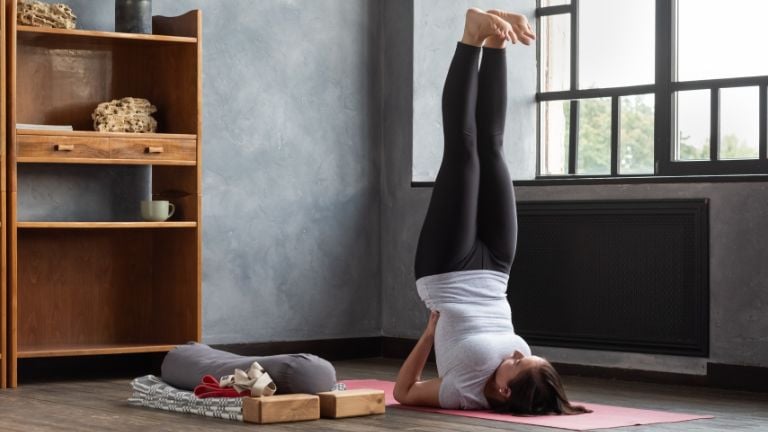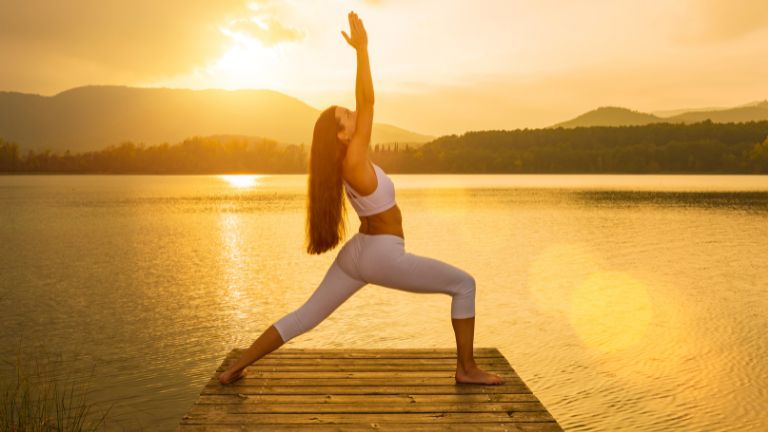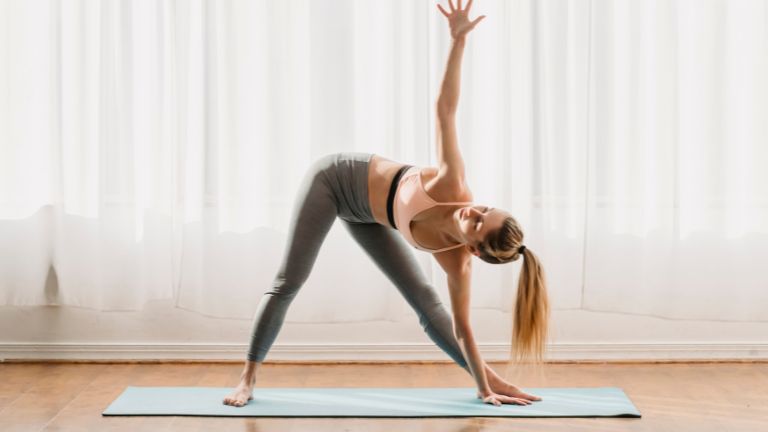Getting a healthy, natural glow of skin is not just about skincare products and makeup—the condition of your skin starts from within.
According to experts, people with glowing and radiant skin are perceived as being more careful and responsible, since this implies that only someone committed and consistent can care for themselves.
Quite the opposite, if you don’t care for your body, especially your skin, you’ll come off as careless, no matter how hard you work.
Yoga is a holistic way to improve your skin from the inside out. Yoga poses, breathwork, and meditation techniques can help you look younger and more radiant.
This post will discuss how yoga can make your skin healthier and show you seven poses that can help you.
Read on to discover yoga’s beauty and anti-aging effects on the skin!

- How Does Yoga Give You Glowing, Youthful Skin?
- Benefits Of Yoga Pose For Glowing Skin
- 1. Improves Circulation
- 2. Promotes Detoxification
- 3. Reduces Stress
- 4. Balances Hormones
- 5. Enhances Digestion
- 6. Promotes Better Sleep
- 7. Enhances Mind-Body Connection
- 7 Best Yoga Poses For Glowing Skin
- 1. Seated Forward Bend Pose
- 2. Shoulder Stand
- 3. Fish Pose
- 4. Standing Forward Bending Pose
- 5. Corpse Pose
- 6. Warrior I Pose
- 7. Triangle Pose
- Bottom Line
- FAQs
- Can yoga whiten skin?
- Can yoga improve skin?
How Does Yoga Give You Glowing, Youthful Skin?
People who do not want to go under the knife or want any artificial work done on their bodies opt for yoga.
Before you start yoga, you must know what issues you want to address. Most people have issues with acne, large pores, dull skin, dry patches, age marks, fine lines, wrinkles, and dead skin cells. All of these things are linked to your lifestyle.
When you do yoga, your skin gets enough blood to detoxify, heal, and replace damaged cells. It improves blood circulation, which helps the face and upper body get more oxygen and nutrients to nourish the skin.
Eventually, the skin quality will improve, and with that, you will notice that the scars will also heal. This doesn’t stop your skin from getting worse; it also reverses the damage and has an anti-aging effect on your skin.
Even a beginner can do the poses without any help from an instructor.
Now, let’s see how yoga affects skin health. And some of the simplest yoga poses you can try to improve your skin.

Benefits Of Yoga Pose For Glowing Skin
Yoga poses benefit your skin in a multitude of ways. From strengthening core muscles to improving oxygen flow throughout the body, these ancient practices will surely give you a glowing complexion.
Regular yoga helps increase circulation and brightens the skin by allowing toxins to be released throughout the body.
Asana (postures) also reduce stress, which can cause breakouts and puffiness. Regular practice releases endorphins (happy hormones), leading to happier, clearer-looking skin radiating from within.
1. Improves Circulation
Yoga poses, especially those involving inversion or where the heart is above the head, help improve blood circulation.
Enhanced circulation means the skin receives more oxygen and nutrients, giving it a radiant glow.
2. Promotes Detoxification
Yoga poses help detoxify the body, which is important for keeping the skin clear and healthy.
Yoga helps clear out toxins from the body and reduces the chance of skin problems like acne. It does this by stimulating the lymphatic system.
3. Reduces Stress
Stress can significantly impact the skin, often leading to issues like acne, eczema, and psoriasis.
Yoga is renowned for its ability to reduce stress and anxiety, thanks to its emphasis on deep, mindful breathing and meditation.
Studies have shown that yoga can effectively lower cortisol and reduce systemic inflammation in the body.
4. Balances Hormones
Yoga practices like breathing exercises and meditation can help balance hormones, improving skin health.
Deep breathing exercises (pranayama) in yoga increase the oxygenation in the body. More oxygen means better cellular health, which is reflected in the skin.

5. Enhances Digestion
People believe yoga aids in digestive health by reducing stress, increasing circulation, and promoting physical movement, or motility, of the gastrointestinal (GI) tract. This can help prevent acne and other skin issues caused by poor digestion.
A 2016 pilot study showed that people taking 16 yoga sessions twice weekly had better IBS symptoms.
6. Promotes Better Sleep
Yoga can improve sleep quality, which allows the skin to repair and regenerate effectively overnight.
Research shows yoga improves sleep quality and duration for many populations. Studies find yoga helps people fall asleep faster, wake less during the night, and feel more rested.
7. Enhances Mind-Body Connection
The mindfulness aspect of yoga helps you understand your body’s needs, including those of your skin. This allows for better care of your skin.
Having a mindful diet can lead to better food choices that positively impact skin health.

7 Best Yoga Poses For Glowing Skin
Practice your way to a glowing complexion with these 7 yoga poses! These postures can help keep your skin looking healthy and radiant by increasing blood circulation, getting rid of toxins, and promoting relaxation.
1. Seated Forward Bend Pose
One of the easiest and simplest poses is the seated forward bend pose, which is also known as Paschimottanasana.
It will improve the blood flow to your face region, and you will notice the heat traveling to the upper part.
The best thing about this pose is that it also improves flexibility in your backbone, which means you are saying goodbye to gaining skin and back pain with just one pose.
How To Do Seated Forward Bend Pose
- Sit on the floor with your legs straight out in front of you.
- Bend forward from your hips, reaching towards your feet.
- If you can, grab your feet or shins with your hands.
- Keep your spine long and your head relaxed.
- Breathe deeply and hold the pose for 30–60 seconds.

2. Shoulder Stand
This can be a little hard, but you can do it with practice. This is generally known as the shoulder stand or Sarvangasana.
You need to balance on your shoulders while your legs are suspended in the air. This helps rush blood to the face, head, and brain regions.
One of the most significant challenges that many people face is the possibility of slipping and requiring assistance with weight adjustment. Therefore, it’s best not to try it unless you’re sure or have someone to help you.
How To Do Shoulder Stand
- Lie on your back on a yoga mat with your knees bent and your feet flat on the floor.
- Place your hands flat beneath your hips with your fingers pointed inward.
- Shift some weight onto your elbows if needed.
- Continue to lift your hips until your legs are straight, and your body is in a straight line from shoulders to knees.
- Hold Shoulder Stand for up to 1 minute, breathing deeply.
- To exit, slowly bend your knees back down overhead.
Note: Be sure to lift through your core for stability. Use caution if you have any neck injuries. If Shoulder Stand feels too hard, change it to Legs Up the Wall.

3. Fish Pose
The Fish Pose, known as Matsyasana in Sanskrit, is a back-bending yoga pose that opens up the throat, chest, and shoulders and is often used as a counterpoise to more forward-bending asanas.
It is an excellent way to improve posture and balance, particularly if you spend much time sitting or hunched over a desk.
Cautions: Avoid Matsyasana if you have high or low blood pressure, migraine, insomnia, or serious lower-back or neck injury.
How To Do Fish Pose
- Lie on your back with your knees bent and feet on the floor.
- Inhale and press your forearms and elbows into the floor. Lift your upper body and head away from the floor.
- Place your hands flat beneath your hips with your fingers pointed forward.
- Stay in the pose for 5–10 breaths.
- To come out of the pose, slowly lower your hips back to the floor and your feet.

4. Standing Forward Bending Pose
Another quite enjoyable pose can aid in accelerating the blood flow to the upper part of the body. Forward bending poses in yoga are considered calming, soothing, and introspective.
This pose puts the head below the heart and helps blood flow to the brain. The folding motion massages the abdominal organs, aiding in digestion.
It stretches the hamstrings, calves, and hips and strengthens the knees and thighs.
Beginner Modifications: If you can’t touch the floor, place your hands on yoga blocks or the shins.
How To Do Forward Bending Pose
- Stand in Tadasana (Mountain Pose) with feet hip-width apart.
- Inhale and extend your torso, lengthening through the spine.
- Exhale and hinge at the hips, folding forward.
- Let your head hang freely, ensuring your neck and shoulders are relaxed.
- Try to bring your chest as close to your legs as possible.
- Make sure your legs are straight without locking the knees.
- Stay in this position for a few breaths.

5. Corpse Pose
The Corpse Pose (Savasana), is a restorative yoga posture typically practiced at the end of a yoga session. The pose aims to rejuvenate the body, mind, and spirit.
It helps reduce stress and anxiety by calming the central nervous system. It also helps the body recover after a yoga session.
Practice in a quiet, peaceful environment to relax.
How to Do Savasana
- Lie on your back with your legs extended, slightly apart, and your arms at your sides, palms facing up.
- Close your eyes and take a deep breath in and out. Let your body feel heavy on the ground.
- Mentally scan your body from head to toe, consciously relaxing each part.
- Allow your breathing to become natural and gentle.
- Try to remain as still as possible, focusing on your breath and the sensations in your body.
- Ideally, stay in Savasana for 5 to 15 minutes.
- When you finish, do it gently.
- Slowly deepen your breath, wiggle your fingers and toes, and roll to one side before sitting up.

6. Warrior I Pose
Virabhadrasana I (Warrior I) is a standing yoga pose that strengthens the muscles of your arms, legs, and abdomen. This pose is known for energizing the entire body and improving stamina.
Furthermore, it will help your skin get rid of toxins by increasing the flow of oxygen-rich blood throughout your body.
It also helps reduce stress levels and can even contribute to feeling more energetic!
How to Do Warrior I
- Begin in Tadasana (Mountain Pose).
- Step your left foot back about 3 to 4 feet, keeping the right foot forward. The left foot should be at a 45-degree angle.
- Turn your hips to face forward, aligning them with the front of the mat.
- Bend your right knee, ensuring it’s directly over the ankle.
- Extend your arms above your head, palms facing each other. Keep your shoulders relaxed.
- Maintain the pose for several breaths, usually 30 seconds to a minute.
- Release the pose, return to Tadasana, and repeat on the opposite side.

7. Triangle Pose
Trikonasana (Triangle Pose) is an excellent pose for stimulating circulation in the abdominal area and improving digestion, which helps keep the skin clear. It also stretches the spine, hamstrings, and hips while releasing tension.
It effectively stretches the hamstrings, inner thighs, and groin, and improves flexibility in the lower body and back.
The focused breathing and concentration required in the pose can help alleviate stress and anxiety.
How to Do Triangle Pose
- Stand with your feet hip-width apart and your toes facing forward.
- Inhale and extend your right arm out to the side, parallel to the floor.
- Bend from your hip and tilt your torso to the right.
- Bring your right hand toward your ankle, shin, or the floor.
- Stretch your left arm up towards the ceiling, forming a straight line with your right arm.
- Turn your head to look up at your left hand.
- Keep your legs and arms straight. Hold the pose for 5–10 breaths.
- Come up to standing, turn your feet in the opposite direction, and repeat on the other side.

Bottom Line
To sum up, it’s all about being committed and consistent. As you begin to practice yoga, your body adjusts to a lifestyle supporting the overall system.
According to experts, you absorb more vitamins D and C with exercise, which makes your skin brighter and more radiant. Also, it will help you eliminate waste and make you sweat more.
You are burning calories and gaining flexibility but also moving towards age reversal.
It will produce more elasticity in your skin, giving you an anti-aging effect without using any anti-aging product.
FAQs
Can yoga whiten skin?
Yoga for Glowing Skin helps cleanse and rejuvenate the skin. Each exhalation in yoga poses for glowing skin removes toxins and purifies the skin.
Can yoga improve skin?
Yoga for glowing skin involves inverted postures that increase blood supply to the head and face and stimulate the nervous system, improving the skin.

Manish brings over 10 years of hands-on experience in weight lifting and fat loss to fitness coaching. He specializes in gym-based training and has a lot of knowledge about exercise, lifting technique, biomechanics, and more.
Through “Fit Life Regime,” he generously shares the insights he’s gained over a decade in the field. His goal is to equip others with the knowledge to start their own fitness journey.
